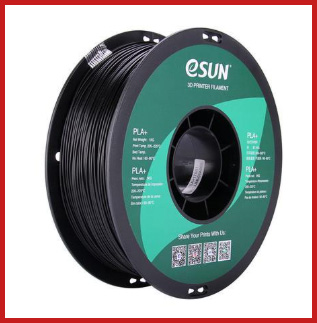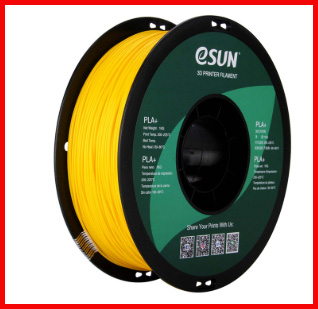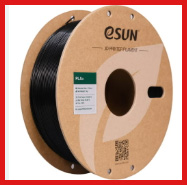Hey there, fellow 3D printing nerds! If you’re on the hunt for a filament that’s affordable, reliable, and versatile enough to bring your wildest creations to life, let me tell you why eSUN filament is worth your attention. I’ve spent countless hours tinkering with my 3D printer, and after testing eSUN’s range, I’m convinced it’s a game-changer for hobbyists and pros alike. In this article, I’ll share my hands-on experience, break down the pros and cons, compare eSUN to other brands, and toss in some maintenance tips to help you get the most out of it. Trust me, you’ll want to add eSUN to your filament stash!
My Experience With Esun Filament

When I first dove into 3D printing, I was overwhelmed by the sheer number of filament brands out there. I started with eSUN PLA+ because it was budget-friendly and had a solid rep on forums like Reddit. My first print was a sleek storage box for my workbench, and let me tell you, the results blew me away. The filament flowed like a dream, and the final product had a smooth, professional finish. Since then, I’ve tried eSUN’s PLA, PETG, ABS, and even their specialty wood filament, printing everything from cosplay props to functional shelf brackets. Each spool has taught me something new about what eSUN brings to the table.
What stands out most is eSUN’s consistency. I’ve burned through dozens of spools, and the quality rarely wavers. The colors pop—especially their Olive Green PLA+—and the prints are sturdy enough for real-world use. I’ve had my fair share of filament fails with other brands, but eSUN’s reliability keeps me coming back. That said, it’s not perfect, and I’ve hit a few bumps along the way, which I’ll get into later. Overall, my experience has been overwhelmingly positive, making eSUN my go-to for most projects.
Pros Of Esun Filament
Let’s talk about why eSUN has earned a permanent spot in my filament lineup. Here are the top reasons you’ll love it:
Read More: My Thought on Ankermake Vs. Bambu Lab
- Affordable Price Point: eSUN filaments typically range from $15.99 to $20.99 per kg, making them a steal compared to premium brands like Prusa or Polymaker. You’re getting high-quality prints without breaking the bank.
- Wide Material Variety: From PLA and PLA+ to PETG, ABS, TPU, and even specialty options like wood or carbon fiber, eSUN’s catalog is a playground for experimenting with different projects.
- Vibrant Color Options: With over 26 colors, including unique shades like rainbow eSilk-PLA, eSUN lets you add flair to your prints. Their Olive Green PLA+ is my personal favorite for its rich, neutral tone.
- Excellent Bed Adhesion: I’ve printed on PEI sheets and glass beds with minimal prep, and eSUN sticks like glue. No more failed first layers or warping nightmares.
- Consistent Diameter Tolerance: eSUN’s filaments maintain a tight ±0.05mm tolerance, ensuring smooth extrusion and fewer clogs. My prints come out precise every time.
- Minimal Stringing: Even on complex models with overhangs, eSUN PLA+ produces clean prints with little to no stringing, saving you post-processing time.
- Eco-Friendly Options: Their PLA is biodegradable, made from plant-based materials like corn and sugarcane. It’s a win for environmentally conscious makers.
- Strong Layer Adhesion: My functional parts, like shelf supports, hold up under stress thanks to eSUN’s excellent layer bonding, especially with PLA+ and PETG.
- Beginner-Friendly: Whether you’re new to 3D printing or a seasoned pro, eSUN’s forgiving print settings (e.g., 190–230°C for PLA+) make it easy to dial in.
- Reliable Packaging: Each spool comes shrink-wrapped with a desiccant packet, keeping moisture at bay. The clear plastic spools are sturdy and easy to store.
These pros make eSUN a no-brainer for anyone looking to balance quality and cost. I’ve printed everything from delicate figurines to rugged tools, and eSUN delivers every time.
Cons Of Esun Filament
No filament is perfect, and eSUN has its quirks. Here’s what you need to watch out for:

- Inconsistent Quality Across Distributors: eSUN filaments are rebranded by third parties like Inland or Intservo, and quality can vary. I’ve had spools from one supplier print flawlessly, while another was a stringy mess.
- Occasional Brittleness: Some PLA spools, especially older ones, can snap if left exposed to humidity. I learned this the hard way when a white PLA spool broke mid-print.
- Moisture Sensitivity: eSUN filaments, particularly PLA, absorb moisture quickly if not stored properly. I’ve seen stringing and popping issues with improperly stored spools.
- Limited High-End Tolerances: While eSUN’s ±0.05mm tolerance is solid, brands like Prusa or Fiberlogy offer tighter tolerances for precision engineering projects.
- PETG Stringing Issues: eSUN’s PETG can be stringy if you don’t tweak retraction settings. I spent hours fine-tuning my Ender 3 to get clean prints.
- Inconsistent Color Batches: I’ve noticed slight shade variations in the same color across different spools, which can be annoying for multi-part projects.
- No Direct eCommerce: You can’t buy directly from eSUN’s website, which feels odd for such a big brand. You’re stuck with third-party retailers like Amazon or Microcenter.
- ABS Fumes: eSUN’s ABS prints well but emits strong fumes, so you’ll need good ventilation or an enclosure, which isn’t ideal for home setups.
- Cardboard Dust on Spools: Some spools, especially from certain distributors, arrive with cardboard dust, which can clog nozzles if you don’t clean them first.
- Not Ideal for High-Stress Mechanical Parts: eSUN PLA is great for general use but lacks the tensile strength for gears or heavy-duty mechanical components.
These cons aren’t dealbreakers, but they require some vigilance. Proper storage and printer tuning can mitigate most issues, but you’ll need to put in the work.
Maintenance And Tips To Get The Most Out Of Esun Filament
To make your eSUN filament shine, you need to treat it right. Here are my top tips to maximize performance:
- Store in a Dry Environment: Use airtight containers with desiccant packets to prevent moisture absorption. I keep my spools in a sealed bin with silica gel to avoid brittleness.
- Use a Filament Dryer: If a spool gets damp, a filament dryer like the eSUN eBox at 50°C for 5–6 hours can restore it. I’ve rescued several spools this way.
- Clean Spools Before Use: Wipe down spools to remove cardboard dust, especially from rebranded distributors. A quick pass with a microfiber cloth does the trick.
- Tweak Retraction for PETG: For eSUN PETG, reduce retraction distance to 3–4mm and speed to 40–50mm/s to minimize stringing. Experimentation is key.
- Optimize Print Temperatures: Start with eSUN’s recommended settings (e.g., 210–230°C for PLA+), but fine-tune based on your printer. I found 205°C works best for my Creality Ender 3.
- Use Adhesives for Bed Adhesion: A thin layer of glue stick or Wolfbite on a clean bed ensures perfect first layers, especially for PLA and PETG.
- Check Distributor Quality: Research your supplier’s quality control standards. I stick with reputable ones like Microcenter’s Inland brand for consistent results.
- Monitor Print Speed: Keep print speeds moderate (40–60mm/s) for PLA+ to avoid warping on overhangs. Slower speeds yield smoother surfaces.
- Use a Brim for Large Prints: For big models, add a brim to increase bed adhesion and reduce warping. It’s saved me from countless failed prints.
- Regular Nozzle Maintenance: eSUN’s eClean filament is great for unclogging nozzles. Run it through your printer every few spools to keep things flowing smoothly.
These tips have turned potential headaches into smooth printing sessions. Trust me, a little prep goes a long way with eSUN.
Esun Vs. Other Brands

How does eSUN stack up against the competition? Let’s compare it to some popular brands to see where it shines and where it falls short.
eSUN vs. Hatchbox
- Price: eSUN is slightly cheaper ($15.99–$20.99/kg) than Hatchbox ($19.99–$24.99/kg), making it a better budget option.
- Quality: Both offer reliable PLA and PETG, but Hatchbox has fewer reports of brittleness. I’ve had more consistent results with eSUN PLA+.
- Variety: eSUN’s catalog is broader, with specialty filaments like wood and carbon fiber. Hatchbox sticks to the basics.
- Availability: Hatchbox is easier to find on Amazon, while eSUN’s availability depends on distributors like Microcenter or Intservo.
- Printability: eSUN’s bed adhesion is top-notch, but Hatchbox PETG strings less with default settings.
- Color Consistency: Hatchbox maintains more consistent colors across batches, which is crucial for multi-part projects.
- Community Feedback: Both are well-loved, but eSUN has a slight edge for functional prints due to PLA+’s strength.
- Verdict: eSUN wins for variety and price, but Hatchbox is a safer bet for color consistency.
eSUN vs. Prusament
- Price: Prusament is pricier ($24.99–$29.99/kg) than eSUN, reflecting its premium status.
- Quality: Prusament’s ±0.02mm tolerance beats eSUN’s ±0.05mm, making it better for precision parts.
- Variety: eSUN offers more specialty filaments, while Prusament focuses on PLA, PETG, and ASA.
- Ease of Use: Both are beginner-friendly, but eSUN’s forgiving settings make it easier to dial in.
- Availability: Prusament’s stock is often low, while eSUN is widely available through third parties.
- Strength: eSUN PLA+ is stronger than Prusament PLA for functional parts, but Prusament’s PETG is less stringy.
- Eco-Friendliness: Both offer biodegradable PLA, but eSUN emphasizes certifications for safety.
- Verdict: Prusament is ideal for precision, but eSUN is more versatile and budget-friendly.
eSUN vs. SUNLU

- Price: SUNLU is slightly cheaper ($14.99–$19.99/kg), but eSUN feels like a step up in quality.
- Quality: eSUN’s PLA+ has better layer adhesion and less warping than SUNLU’s PLA Meta.
- Variety: Both have diverse catalogs, but eSUN’s specialty filaments like eSilk-PLA stand out.
- Printability: eSUN prints smoother with less fine-tuning, while SUNLU needs careful bed adhesion tweaks.
- Color Options: eSUN’s colors are more vibrant, while SUNLU’s can vary slightly in shade.
- Durability: eSUN PLA+ is less brittle, making it better for functional prints.
- Community Buzz: eSUN has a stronger following for reliability, while SUNLU is praised for speed.
- Verdict: eSUN edges out SUNLU for quality and versatility, but SUNLU is great for tight budgets.
eSUN holds its own against these heavyweights, offering a sweet spot of affordability, variety, and performance. If you’re after precision, Prusament might be your pick, but eSUN’s versatility makes it hard to beat.
Frequently Asked Questions (Faq)
Yes, eSUN filament is generally high quality, especially their PLA+ and PETG. I’ve found their prints to be smooth, with excellent bed adhesion and minimal stringing when settings are dialed in. However, quality can vary depending on the distributor, so stick with trusted ones like Microcenter or Intservo. Their ±0.05mm tolerance ensures consistent extrusion, making them a reliable choice for most projects.
Absolutely, eSUN is a legitimate company founded in 2002 in Shenzhen, China. They’re a global leader in 3D printing materials, known for their R&D in biodegradable polymers like PLA. Their website is professional, and they have a strong presence on social media. I’ve never had issues with their products or authenticity when buying from reputable retailers.
eSUN’s main drawbacks include occasional brittleness in PLA if not stored properly, stringing with PETG without tuned settings, and inconsistent quality from some distributors. Their ABS requires good ventilation due to fumes, and color batches can vary slightly. It’s also not ideal for high-stress mechanical parts due to limited tensile strength.
eSUN filament is manufactured by eSUN Industrial Co., a Chinese company established in 2002. They specialize in biodegradable polymers and have expanded into a wide range of 3D printing materials, including PLA, ABS, PETG, and specialty filaments. Their focus on innovation and affordability has made them a favorite among 3D printing enthusiasts worldwide.
Conclusion
Read More: My Thought on Ankermake Vs. Bambu Lab
If you’re looking to elevate your 3D printing game without emptying your wallet, eSUN filament is the way to go. My journey with their PLA+, PETG, and specialty filaments has been a blast, delivering vibrant, sturdy prints for everything from cosplay props to functional parts. With a little care and some printer tweaks, eSUN can rival pricier brands while keeping your budget intact. Grab a spool, follow my maintenance tips, and start printing your next masterpiece—you won’t be disappointed!
